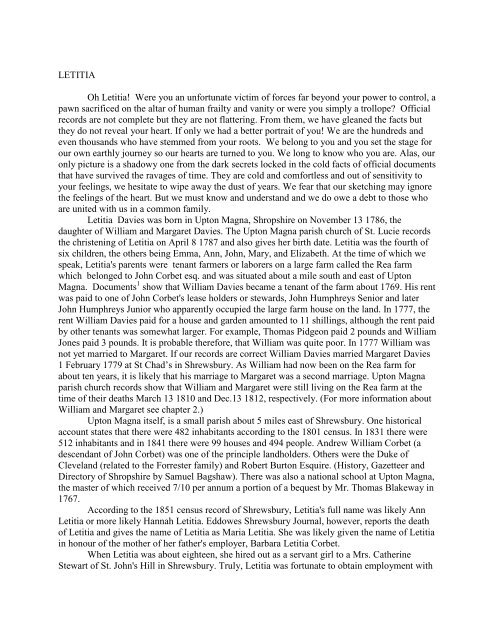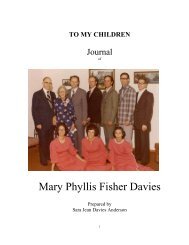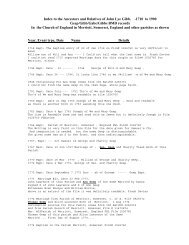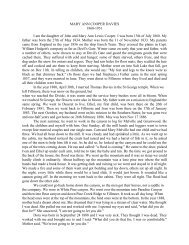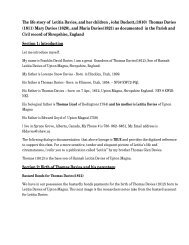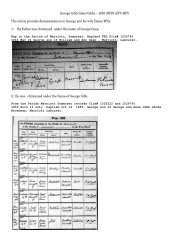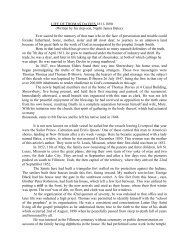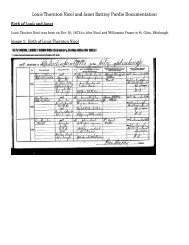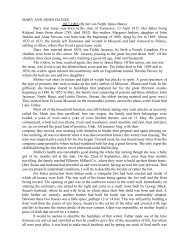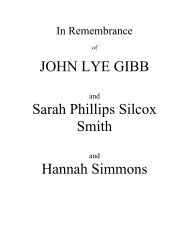LETITIA Oh Letitia! Were you an unfortunate victim ... - Thomas Davies
LETITIA Oh Letitia! Were you an unfortunate victim ... - Thomas Davies
LETITIA Oh Letitia! Were you an unfortunate victim ... - Thomas Davies
Create successful ePaper yourself
Turn your PDF publications into a flip-book with our unique Google optimized e-Paper software.
<strong>LETITIA</strong><br />
<strong>Oh</strong> <strong>Letitia</strong>! <strong>Were</strong> <strong>you</strong> <strong>an</strong> <strong>unfortunate</strong> <strong>victim</strong> of forces far beyond <strong>you</strong>r power to control, a<br />
pawn sacrificed on the altar of hum<strong>an</strong> frailty <strong>an</strong>d v<strong>an</strong>ity or were <strong>you</strong> simply a trollope? Official<br />
records are not complete but they are not flattering. From them, we have gle<strong>an</strong>ed the facts but<br />
they do not reveal <strong>you</strong>r heart. If only we had a better portrait of <strong>you</strong>! We are the hundreds <strong>an</strong>d<br />
even thous<strong>an</strong>ds who have stemmed from <strong>you</strong>r roots. We belong to <strong>you</strong> <strong>an</strong>d <strong>you</strong> set the stage for<br />
our own earthly journey so our hearts are turned to <strong>you</strong>. We long to know who <strong>you</strong> are. Alas, our<br />
only picture is a shadowy one from the dark secrets locked in the cold facts of official documents<br />
that have survived the ravages of time. They are cold <strong>an</strong>d comfortless <strong>an</strong>d out of sensitivity to<br />
<strong>you</strong>r feelings, we hesitate to wipe away the dust of years. We fear that our sketching may ignore<br />
the feelings of the heart. But we must know <strong>an</strong>d underst<strong>an</strong>d <strong>an</strong>d we do owe a debt to those who<br />
are united with us in a common family.<br />
<strong>Letitia</strong> <strong>Davies</strong> was born in Upton Magna, Shropshire on November 13 1786, the<br />
daughter of William <strong>an</strong>d Margaret <strong>Davies</strong>. The Upton Magna parish church of St. Lucie records<br />
the christening of <strong>Letitia</strong> on April 8 1787 <strong>an</strong>d also gives her birth date. <strong>Letitia</strong> was the fourth of<br />
six children, the others being Emma, Ann, John, Mary, <strong>an</strong>d Elizabeth. At the time of which we<br />
speak, <strong>Letitia</strong>'s parents were ten<strong>an</strong>t farmers or laborers on a large farm called the Rea farm<br />
which belonged to John Corbet esq. <strong>an</strong>d was situated about a mile south <strong>an</strong>d east of Upton<br />
Magna. Documents 1 show that William <strong>Davies</strong> became a ten<strong>an</strong>t of the farm about 1769. His rent<br />
was paid to one of John Corbet's lease holders or stewards, John Humphreys Senior <strong>an</strong>d later<br />
John Humphreys Junior who apparently occupied the large farm house on the l<strong>an</strong>d. In 1777, the<br />
rent William <strong>Davies</strong> paid for a house <strong>an</strong>d garden amounted to 11 shillings, although the rent paid<br />
by other ten<strong>an</strong>ts was somewhat larger. For example, <strong>Thomas</strong> Pidgeon paid 2 pounds <strong>an</strong>d William<br />
Jones paid 3 pounds. It is probable therefore, that William was quite poor. In 1777 William was<br />
not yet married to Margaret. If our records are correct William <strong>Davies</strong> married Margaret <strong>Davies</strong><br />
1 February 1779 at St Chad’s in Shrewsbury. As William had now been on the Rea farm for<br />
about ten years, it is likely that his marriage to Margaret was a second marriage. Upton Magna<br />
parish church records show that William <strong>an</strong>d Margaret were still living on the Rea farm at the<br />
time of their deaths March 13 1810 <strong>an</strong>d Dec.13 1812, respectively. (For more information about<br />
William <strong>an</strong>d Margaret see chapter 2.)<br />
Upton Magna itself, is a small parish about 5 miles east of Shrewsbury. One historical<br />
account states that there were 482 inhabit<strong>an</strong>ts according to the 1801 census. In 1831 there were<br />
512 inhabit<strong>an</strong>ts <strong>an</strong>d in 1841 there were 99 houses <strong>an</strong>d 494 people. Andrew William Corbet (a<br />
descend<strong>an</strong>t of John Corbet) was one of the principle l<strong>an</strong>dholders. Others were the Duke of<br />
Clevel<strong>an</strong>d (related to the Forrester family) <strong>an</strong>d Robert Burton Esquire. (History, Gazetteer <strong>an</strong>d<br />
Directory of Shropshire by Samuel Bagshaw). There was also a national school at Upton Magna,<br />
the master of which received 7/10 per <strong>an</strong>num a portion of a bequest by Mr. <strong>Thomas</strong> Blakeway in<br />
1767.<br />
According to the 1851 census record of Shrewsbury, <strong>Letitia</strong>'s full name was likely Ann<br />
<strong>Letitia</strong> or more likely H<strong>an</strong>nah <strong>Letitia</strong>. Eddowes Shrewsbury Journal, however, reports the death<br />
of <strong>Letitia</strong> <strong>an</strong>d gives the name of <strong>Letitia</strong> as Maria <strong>Letitia</strong>. She was likely given the name of <strong>Letitia</strong><br />
in honour of the mother of her father's employer, Barbara <strong>Letitia</strong> Corbet.<br />
When <strong>Letitia</strong> was about eighteen, she hired out as a serv<strong>an</strong>t girl to a Mrs. Catherine<br />
Stewart of St. John's Hill in Shrewsbury. Truly, <strong>Letitia</strong> was fortunate to obtain employment with
Mrs Stewart as her employer belonged to one of the most prestigious families of Shropshire.<br />
<strong>Letitia</strong> was a serv<strong>an</strong>t in Mrs. Stewart's home for about four years.<br />
To underst<strong>an</strong>d what happened to <strong>Letitia</strong>, it is import<strong>an</strong>t to know a little history 2 of Mrs.<br />
Stewart's family. Mrs. Catherine Stewart was the wife of Captain Gilbert Shuckburgh Stewart<br />
Esquire, captain of the 68th Regiment of Foot. She was also the daughter of Lord Cecil Forrester.<br />
The Forrester family was one of the most prestigious families in Shropshire. They held extensive<br />
property in Upton Magna <strong>an</strong>d other parts of Shropshire. Lord Cecil Forrester was the member of<br />
parliament for Much Wenlock, Shropshire <strong>an</strong>d his wife was the sister of the Duke of Rutl<strong>an</strong>d.<br />
The Forrester family circulated amongst the very highest of the nobility of Engl<strong>an</strong>d. Certainly,<br />
there were very few people from Shropshire with higher r<strong>an</strong>k.<br />
Mrs. Stewart also had a <strong>you</strong>nger brother named Fr<strong>an</strong>cis Forrester, the fifth son of Lord<br />
Cecil Forrester. He was christened at St. Chad’s in Shrewsbury 19 August 1774. He was a major<br />
of the 15th Hussars <strong>an</strong>d the Royal Horse Guards. On July 22, 1813, he married Lady Louisa<br />
Catherine Barbara V<strong>an</strong>e, eldest daughter of the Earl of Darlington <strong>an</strong>d first Duke of Clevel<strong>an</strong>d.<br />
At a later period after the time of which we speak, Fr<strong>an</strong>cis took his brother’s place as a member<br />
of parliament on the occasion of his older brother’s elevation to the peerage (Baron Cecil<br />
Forrester). Undoubtedly, Major Fr<strong>an</strong>ces Forrester visited his sister, Mrs. Stewart, a number of<br />
times <strong>an</strong>d on one of these visits, <strong>Letitia</strong> became pregn<strong>an</strong>t. It is not surprising that a <strong>you</strong>ng serv<strong>an</strong>t<br />
girl was flattered by the attention of a major in the army of such stature as Fr<strong>an</strong>ces Forrester. She<br />
must have been sufficiently pretty to attract his attention, as well, even if it was for all the wrong<br />
reasons. What happened to <strong>Letitia</strong> when this event became known is uncertain except that her<br />
employment with Mrs. Stewart was terminated. With no place to go <strong>an</strong>d with no me<strong>an</strong>s to<br />
support herself, she went to the house of Industry where she probably worked under very harsh<br />
conditions until her baby was born. Why she did not go home to her mother's place, five miles<br />
away (her father died just a few months previous to the birth of <strong>Letitia</strong>'s child) is not known<br />
except that settlements laws probably prohibited it. Thus it was at the house of Industry that she<br />
gave birth to her child which occurred on June 14, 1810. The child was a boy. At the house of<br />
Industry her confinement was not free as she was required to pay for two nurses for the delivery.<br />
<strong>Letitia</strong> did not have the money to pay for these services. In those days, as at other times, the<br />
community officers did not w<strong>an</strong>t to have illegitimate children of poor mothers thrown upon them<br />
for support. On orders of Mr. Joseph Asterley, the chairm<strong>an</strong> of the Board of the House of<br />
Industry, Fr<strong>an</strong>cis Forrester was solicited to determine what he would do to support the child. He<br />
agreed to pay to the house of Industry a sum of thirty guineas (30 lbs 10 shillings - ) in a lump<br />
payment with no further responsibility for the boy child. What happened to this child was not<br />
known until recently, nor did we know the child's name. What happened to <strong>Letitia</strong> next is also<br />
uncertain. She apparently returned to Upton Magna without the baby <strong>an</strong>d so it was assumed that<br />
the child had died. What trauma this experience caused <strong>Letitia</strong> we c<strong>an</strong> only imagine, nor do we<br />
underst<strong>an</strong>d clearly what shame <strong>an</strong>d hurt <strong>an</strong>d despair she had to endure. Accounts of similar<br />
occurrences of the time suggest that it was a very sad <strong>an</strong>d degrading experience. What is clear is<br />
that she could not support the child <strong>an</strong>d was therefore under the necessity to give it up.<br />
Recent documents* obtained from the parish of Condover, however, show that the child<br />
did not die but was raised by John Duckett <strong>an</strong>d his wife Sarah Wheeler. The parish record at<br />
Condover indicates that <strong>Letitia</strong>’s child was known as John Duckett. John Duckett was christened<br />
on October 11 1829 as <strong>an</strong> adult, the son of Fr<strong>an</strong>cis Forester esquire <strong>an</strong>d <strong>Letitia</strong> <strong>Davies</strong> serv<strong>an</strong>t.<br />
At the time of christening, he was nineteen years of age. It is ironical that the father was<br />
mentioned in the parish record holding the titles of his r<strong>an</strong>k <strong>an</strong>d <strong>Letitia</strong> was called a serv<strong>an</strong>t.
Subsequent records show that John kept the name of Duckett, for a marriage by b<strong>an</strong>ns is<br />
recorded at Condover on 16 October 1832 between John Duckett <strong>an</strong>d Eliza Griffith. The records<br />
end on a note of sadness for the death of John occurred soon after. The Condover record states<br />
John Duckett, abode Bayston Hill, buried 16 Feb 1834 age 22. Condover is not far from<br />
Shrewsbury but we have no record of <strong>an</strong>y contact between John <strong>an</strong>d his mother. Reflection<br />
suggests sadly that John was probably more attached to his foster parents th<strong>an</strong> his mother with<br />
whom he probably had little or no contact. Was he bitter that she ab<strong>an</strong>doned him even though<br />
she was not able to care for him <strong>an</strong>d was likely forced to give him up by the house of Industry or<br />
poverty? Hopefully, he was loved by his adopted parents. What is certain is that the 30 guineas<br />
received for his birth did not go to <strong>Letitia</strong> but to the house of Industry <strong>an</strong>d to the parents who<br />
raised him.<br />
There is one further reference of import<strong>an</strong>ce to this story. A birth of a son, Charles<br />
William Duckett, born to John Duckett <strong>an</strong>d Eliza is recorded at St Juli<strong>an</strong>’s parish in Shrewsbury<br />
on 20 Jun 1833. It has not been established that this child is the son of our John Duckett, but<br />
Condover is close to Shrewsbury <strong>an</strong>d the birth of the child would fit our records neatly. After<br />
the death of John Duckett, no further record of his wife Eliza has yet been uncovered.<br />
Our next record about <strong>Letitia</strong> is of the birth of her son, <strong>Thomas</strong>. The Upton Magna parish<br />
record states on 5 May 1812 that <strong>Thomas</strong>, the base son of <strong>Letitia</strong> <strong>Davies</strong> was baptized. From this<br />
parish record, the <strong>Davies</strong> family has assumed that <strong>Thomas</strong> was born at Upton Magna. However,<br />
the Shrewsbury Incorporation Contributors Ledger suggests otherwise. The Shrewsbury<br />
Contributors ledger provides records of Bastardy Bonds (i.e., in order not to be a burden on the<br />
community, poor mother's of illegitimate children were required to name the father so the courts<br />
could force the father to give support). The Bastardy Bonds show that in the parish of St. Juli<strong>an</strong>s,<br />
Shrewsbury <strong>Thomas</strong> Lloyd of Rodington, farmer's serv<strong>an</strong>t, paid to the House of Industry L 2-11-<br />
3 lying in expenses (birth expenses) for a male child delivered by <strong>Letitia</strong> <strong>Davies</strong> which was born<br />
7 April1812. It is evident that <strong>Letitia</strong> went to the House of Industry to give birth. Beginning<br />
February 16 1813, about a year later, <strong>Thomas</strong> Lloyd was ordered by the court to pay 1 s 3 p a<br />
week to support the child which he did until 3 May 1814. Apparently the house of Industry was<br />
caring for the child during this time (February 16 1813 to May 13 1814.) What happened to<br />
<strong>Letitia</strong> from the birth of the child until the order for support was made? I c<strong>an</strong> only speculate but<br />
<strong>Letitia</strong> may have gone with her child to Upton Magna to live with her mother Margaret. She may<br />
even have gone there to be near <strong>Thomas</strong> Lloyd <strong>an</strong>d she may have expected him to marry her for<br />
<strong>Thomas</strong> Lloyd resided at Upton Magna or in the parish of Rodington two miles away. No<br />
marriage took place however. Then when <strong>Letitia</strong>’s mother died, 13 December 1812, <strong>Letitia</strong> was<br />
forced to return to the House of Industry for support. At this point the court ordered <strong>Thomas</strong><br />
Lloyd to pay 1s 3p a week for the child’s upkeep. When he stopped payment it is probable that<br />
<strong>Letitia</strong> had to find other me<strong>an</strong>s of support. Her meager income would hardly maintain herself <strong>an</strong>d<br />
her child. Regardless of the circumst<strong>an</strong>ces one c<strong>an</strong> see that <strong>Letitia</strong> was mired in a cycle of deep<br />
poverty <strong>an</strong>d degradation.<br />
What of <strong>Thomas</strong> Lloyd? Examination of the parish record of Rodington which borders on<br />
Upton Magna (a few miles east <strong>an</strong>d north) gives the baptism of <strong>Thomas</strong> Lloyd December 26<br />
1784, son of Edward <strong>an</strong>d Elizabeth Lloyd. He was thus two years older th<strong>an</strong> <strong>Letitia</strong>. Soon after<br />
this time he married a girl by the name of Elizabeth <strong>an</strong>d lived at Upton Magna for a while <strong>an</strong>d<br />
then settled at Rodington where he lived until his death.<br />
Unlike the first baby born to <strong>Letitia</strong>, this child was raised by her <strong>an</strong>d he is the great<br />
gr<strong>an</strong>dfather of the writer of this account. It is import<strong>an</strong>t to acknowledge the difference in the
irths of the two children. John Duckett may have been partly supported by Fr<strong>an</strong>cis Forester. He<br />
certainly would not do so if the child was under <strong>Letitia</strong>’s care (To do so he would have to<br />
acknowledge his relationship with a serv<strong>an</strong>t girl <strong>an</strong>d that would not satisfy his reputation.) On the<br />
other h<strong>an</strong>d <strong>Letitia</strong> was the only support for her son, <strong>Thomas</strong>, <strong>an</strong>d so he remained under her care<br />
in his growing up years.<br />
In later years, a number of <strong>Thomas</strong> <strong>Davies</strong>' church documents have been preserved that<br />
list various names for his father. The most common name was <strong>Thomas</strong> F, <strong>an</strong>d this was assumed<br />
to be <strong>Thomas</strong> Fr<strong>an</strong>k or <strong>Thomas</strong> Fr<strong>an</strong>cis. Another name listed is Richard <strong>Davies</strong>. On the L.D.S.<br />
church temple records, for example, the name of <strong>Thomas</strong> Fr<strong>an</strong>k <strong>Davies</strong> was accepted. This is, of<br />
course, <strong>an</strong> error but it may have been perpetuated by <strong>Thomas</strong> <strong>Davies</strong>’ own statements. Whether<br />
he actually did not know the name of his father or whether he repeated a little untruth to protect<br />
his own name or the name of his mother we do not know. It may be that he was ashamed to<br />
admit that his birth was to a single mother or else embarrassed to explain. On the other h<strong>an</strong>d, <strong>an</strong>y<br />
misunderst<strong>an</strong>ding may actually be <strong>an</strong> interpolation by the hearer. For example, in a document<br />
appointing him to a priesthood office in the Church of Jesus Christ of Latter-day Saints, the<br />
name of his father is given as <strong>Thomas</strong> (with no surname), while the name of his mother is given<br />
as <strong>Letitia</strong> <strong>Davies</strong>. Since <strong>Thomas</strong>'s own surname was <strong>Davies</strong> it may have been only <strong>an</strong><br />
assumption by his descend<strong>an</strong>ts that his father was also named <strong>Davies</strong> <strong>an</strong>d this misunderst<strong>an</strong>ding<br />
persisted. In <strong>an</strong>y case, the names of <strong>Thomas</strong> <strong>an</strong>d Fr<strong>an</strong>cis or Fr<strong>an</strong>k seem to be derived from<br />
<strong>Thomas</strong> Lloyd <strong>an</strong>d Fr<strong>an</strong>cis Forrester, the fathers of <strong>Letitia</strong>'s first two children. In as much as<br />
<strong>Letitia</strong> <strong>Davies</strong> <strong>an</strong>d <strong>Thomas</strong> Lloyd were not married, it was natural for <strong>Thomas</strong> to keep the<br />
surname of <strong>Davies</strong> <strong>an</strong>d so this is the name by which the descend<strong>an</strong>ts of <strong>Thomas</strong> <strong>Davies</strong> are<br />
known.<br />
<strong>Letitia</strong> had four more children but only two of them lived to maturity. In each case, the<br />
child is listed as being or it is intimated as being born to a single wom<strong>an</strong>. From the St. Mary's<br />
parish register the following baptisms are recorded:<br />
Dec. 14 1816, Sarah daughter of <strong>Letitia</strong> <strong>Davies</strong> of Castle Foregate. (I am not sure this<br />
child is the child of our <strong>Letitia</strong> <strong>Davies</strong>.)<br />
Sept. 24 1820, Mary daughter of <strong>Letitia</strong> <strong>Davies</strong> of Raven Street. According to the record,<br />
Mary was christened in the church at this time, but she was born July 13 1818 according to<br />
bastardy examinations See notes at the end).<br />
In the St. Chad's parish register the following are also recorded:<br />
Maria the illegitimate daughter of <strong>Letitia</strong> <strong>Davies</strong> of Barker Street, dressmaker, was baptized 21<br />
July 1821. Maria's birth is recorded as being 10 June 1821.<br />
5 July 1827, James son of <strong>Letitia</strong> <strong>Davies</strong>, Barker Street, single wom<strong>an</strong>.<br />
Mary <strong>an</strong>d Maria both lived to maturity. Settlement documents are recorded in the case of<br />
Mary <strong>an</strong>d Maria, <strong>an</strong>d in both cases, the father is listed as being Robert Edwards, bricklayer. No<br />
surety bonds have been found for James or Sarah <strong>an</strong>d it is likely that they both died soon after<br />
birth. It is not known who the father of these latter two was although it is very probable that<br />
Robert Edwards who lived down the street is the father of James as well as Mary <strong>an</strong>d Maria. In<br />
<strong>an</strong>y case, James <strong>an</strong>d Sarah did not appear on <strong>an</strong>y census or church record there after. They did<br />
live long enough to be baptized however. The following statistics are recorded for St. Chad's<br />
parish on 20 June 1827 about the time of James' birth.<br />
Barker Street Under 10 Males Females Totals<br />
# 260 Robert Edwards 1 1 5 6
#430 Mary <strong>Davies</strong> 1 3 2 5<br />
#465 <strong>Letitia</strong> <strong>Davies</strong> 2 1 3 4<br />
From the above data it is easy to reconcile the living family of <strong>Letitia</strong>: Mary <strong>an</strong>d Maria<br />
were both under ten at the time, <strong>Thomas</strong>, the one male in the home was 15. James had not yet<br />
been born but <strong>Letitia</strong> was about 7 - 8 months pregn<strong>an</strong>t. Sarah is not included <strong>an</strong>d must have<br />
already died. In Robert Edwards home, 2 of the total of 6 are listed as boarders. The other three<br />
likely were his own immediate family.<br />
It would be futile to try <strong>an</strong>d follow <strong>Letitia</strong>'s life too closely during these years. That she<br />
gave birth to six children out of wedlock is unusual, but may be more the result of the harshness<br />
of her living conditions th<strong>an</strong> <strong>an</strong>ything else. Two official documents give some suggestion as to<br />
her living conditions. When she was six months pregn<strong>an</strong>t with Mary <strong>an</strong>d again when nearly nine<br />
months with Maria, she was called before the Shrewsbury justices of the peace for "Settlement<br />
Examinations." By act of parliament, a settlement law was in force which governed the right of<br />
poor people to move from one parish to <strong>an</strong>other. It was enacted to prevent the poor from<br />
becoming a burden on <strong>an</strong>other parish. In <strong>Letitia</strong>'s case, she was expecting a child <strong>an</strong>d she was<br />
being examined as to her right to live in St. Chad's in Shrewsbury. In both cases, she defended<br />
her right to be in Shrewsbury, by the fact that she had been employed by Mrs. Catherine Stewart<br />
<strong>an</strong>d had resided in Shrewsbury since that time. (Note: Settlement Laws were different from Bastardy<br />
Bonds. In the case of <strong>Letitia</strong>’s first two children, <strong>Letitia</strong> went to the House of Industry to give birth <strong>an</strong>d the father<br />
had to pay the expenses. In the case of Mary <strong>an</strong>d Maria the Settlement Examinations occurred before birth of the<br />
child <strong>an</strong>d the examination was to determine if <strong>Letitia</strong> had a right to live in Shrewsbury.) One c<strong>an</strong> deduce from<br />
these circumst<strong>an</strong>ces that <strong>Letitia</strong> was very poor. At some point, she set up a shop as a milliner <strong>an</strong>d<br />
dress maker. She is listed as a dressmaker before Maria's birth <strong>an</strong>d she pursued this occupation<br />
until her death. It was not likely a very high paying profession <strong>an</strong>d it must have been difficult for<br />
her to make ends meet. At various times, she took in boarders. The 1841 census lists <strong>Thomas</strong><br />
Wilmott, policem<strong>an</strong>, as a boarder at her home.<br />
<strong>Letitia</strong> signed her name with <strong>an</strong> "x" on all the court documents available to us <strong>an</strong>d so she<br />
could neither read nor write. Neither could her daughters, although <strong>Thomas</strong> <strong>Davies</strong> in his<br />
marriage of 1834 did sign his name <strong>an</strong>d so he was somewhat literate. In 1847, he was made the<br />
clerk of the small br<strong>an</strong>ch of the L.D.S. church in Shrewsbury <strong>an</strong> assignment that did require him<br />
to read <strong>an</strong>d write. Where he obtained his skill to read is not known as poor people seldom had<br />
this privilege. As <strong>an</strong> apprentice shoemaker, he may have had the privilege of some education. It<br />
should be noted that although there was a school in Upton Magna when <strong>Letitia</strong> was a child, it is<br />
likely she was not allowed to attend it <strong>an</strong>d could not have afforded to do so in <strong>an</strong>y case.<br />
There is very little information about the growing up years of <strong>Letitia</strong>'s children. Court<br />
documents dated July 15 1825, however, indicate that at the Quarter Sessions for Shrewsbury,<br />
<strong>Thomas</strong> <strong>Davies</strong> aged 14, a shoemaker was charged with four other <strong>you</strong>ths of stealing from the<br />
union wharf 12 pounds of tallow valued at four shillings. One c<strong>an</strong> see from this case how severe<br />
<strong>an</strong>d heavy the punishment of the law was. Two of the <strong>you</strong>ths r<strong>an</strong>ging in age from 11 - 14 were<br />
acquitted, but the other three, including <strong>Thomas</strong> <strong>Davies</strong>, were sentenced to one month<br />
imprisonment at hard labor <strong>an</strong>d to be privately whipped on July 16 <strong>an</strong>d again before being<br />
discharged. It is certain that this is <strong>Letitia</strong>'s son, for the name <strong>an</strong>d age fit <strong>an</strong>d he was a shoemaker<br />
in later years of life. It is likely at this early age he was apprenticed to a shoemaker. One of the<br />
other apprehended <strong>you</strong>ths of the same age was also listed as a shoemaker. In this document,<br />
<strong>Thomas</strong> is listed as being born at Shrewsbury which we have already indicated is most likely.
Again, from November 11, 1829 until April 19 1830, <strong>Thomas</strong> <strong>Davies</strong>, shoemaker is<br />
committed to the county jail. The citation is made on 16 J<strong>an</strong>uary 1830 <strong>an</strong>d reads: "for refusing to<br />
find sureties for his personal appear<strong>an</strong>ce at the sessions, <strong>an</strong>d in the me<strong>an</strong>time to be of good<br />
behavior towards our Lord the King <strong>an</strong>d all his liege people: committed the 11th day of<br />
November 1829, by Robert Gray, Esquire Mayor." The nature of the misdeme<strong>an</strong>or is not given<br />
in the document but the above citation indicates that he was imprisoned for lack of money to pay<br />
the fine for his misdeme<strong>an</strong>or. Considering his circumst<strong>an</strong>ces <strong>an</strong>d the circumst<strong>an</strong>ces of his<br />
mother, it is not surprising that he could not find the me<strong>an</strong>s to forgo the imprisonment.<br />
Considering also, what little we know of his home life, it should not be surprising that his<br />
growing up years were difficult ones. It should be noted that <strong>Thomas</strong> <strong>Davies</strong>’ uncle, John<br />
<strong>Davies</strong>, was a shoemaker at Upton Magna <strong>an</strong>d it may be that <strong>Thomas</strong> was apprenticed out to his<br />
Uncle John.<br />
<strong>Thomas</strong> <strong>Davies</strong> married Mary Simmons, daughter of John <strong>an</strong>d Sus<strong>an</strong> Simmons (or<br />
Simmonds) in St. Mary's church on Nov. 24 1834. The marriage record of St. Mary's states:<br />
"<strong>Thomas</strong> <strong>Davies</strong>, bachelor (of this parish) <strong>an</strong>d Mary Simmones, spinster (of this parish) married<br />
24 November 1834. <strong>Thomas</strong> <strong>Davies</strong> then signed his name. Mary, his wife signed with <strong>an</strong> "x".<br />
The witnesses were Joseph Simmones (brother to Mary) <strong>an</strong>d Mary Cox both of whom signed<br />
with <strong>an</strong> "x". At the time, <strong>Thomas</strong> was 23 years of age. No children seem to have been born to<br />
this couple. Family tradition indicated that a daughter Emily was born to them about 1846, but<br />
this tradition has been proven wrong as Emily was the daughter of <strong>Thomas</strong>'s sister, Maria.<br />
In 1847, <strong>Thomas</strong> joined the Church of Jesus Christ of Latter-day Saints (Mormon). A<br />
copy of a letter by the missionary who converted <strong>Thomas</strong> (T. D. Brown) in possession of the<br />
writer indicates that <strong>Thomas</strong> was the first person in Shrewsbury to become a Mormon. Soon<br />
afterwards he was appointed the clerk of the br<strong>an</strong>ch of the church in the area. With some<br />
opposition, <strong>Thomas</strong> decided to immigrate to America. Records show that on Nov. 22, 1848, he<br />
boarded a ship at Liverpool, the Lord S<strong>an</strong>don, with 11 other Latter-day Saints <strong>an</strong>d arrived at New<br />
Orle<strong>an</strong>s on 17 February 1849. On this journey to America, his wife, Mary, did not accomp<strong>an</strong>y<br />
him, but a short time after his arrival in America, he was apprised of Mary's death of Asiatic<br />
cholera on 31 August 1849. Although it is not verified, <strong>an</strong> autobiography of <strong>Thomas</strong> <strong>Davies</strong> by<br />
his adopted son, Nephi James Bates, states that <strong>Thomas</strong>’s wife left him when <strong>Thomas</strong> joined the<br />
church.<br />
Neither did his mother or two sisters emigrate with him nor do we have a record of them<br />
joining the church.<br />
Subsequently, on 6 December 1850 at New Orle<strong>an</strong>s, <strong>Thomas</strong> married a two times widow,<br />
Mary Anne Jones Jacaway Bates, who had three children. At this time, <strong>Thomas</strong> was 38 years of<br />
age. To this union, three more children were born: <strong>Letitia</strong> Maria, <strong>Thomas</strong> Junior <strong>an</strong>d Mellisa<br />
Ann. It is interesting to note that <strong>Thomas</strong> named his first daughter after his mother <strong>an</strong>d his sister<br />
Maria.<br />
<strong>Thomas</strong> moved to Fillmore in Utah with his family <strong>an</strong>d lived there until his death Aug. 2,<br />
1890. <strong>Thomas</strong> died of diphtheria which also claimed the life of his daughter <strong>Letitia</strong> Maria <strong>an</strong>d<br />
three of her children at the same time.<br />
For the most part, Mary <strong>an</strong>d Maria continued to live with their mother in Shrewsbury <strong>an</strong>d<br />
neither of them married. The 1851 census of Shrewsbury indicates that <strong>Letitia</strong> was living at<br />
Bellstone:<br />
Ann L <strong>Davies</strong> Head Widow 63 Milliner born Upton Magna
Mary <strong>Davies</strong> daughter unmarried 29 Milliner born Shrewsbury<br />
Maria <strong>Davies</strong> daughter unmarried 27 Milliner born Shrewsbury<br />
Emelia <strong>Davies</strong> gr<strong>an</strong>d daughter 5 Scholar born Shrewsbury<br />
There is some discrep<strong>an</strong>cy between the ages of the three women <strong>an</strong>d documents already<br />
cited but they are undoubtedly the family of this sketch.<br />
<strong>Letitia</strong> died at Bellstone Shrewsbury on 12 May 1866 at the age of 79 years. The cause of<br />
death is recorded as decay of nature. Her daughter Maria, aged 44, died the following day of<br />
dropsy. They were both buried May 17, 1866. Mary died 12 Nov. 1900. <strong>Letitia</strong> <strong>an</strong>d her two<br />
daughters, Mary <strong>an</strong>d Maria , were buried in the same plot in the Shrewsbury General Cemetery .<br />
Also buried in the same plot are Fr<strong>an</strong>k Henry <strong>Davies</strong> <strong>an</strong>d Emily Helen <strong>Davies</strong> Marshall, children<br />
of Maria. (Section 107, division 5c)<br />
Mary <strong>Davies</strong> had one child. A birth certificate in the possession of the writer indicates<br />
that Mary lived in Barker Street, St. Chad, Shrewsbury at the time <strong>an</strong>d the child, a boy, was born<br />
May 10, 1846. The birth was registered May 23, 1846. No name is given on the birth certificate<br />
for this child, nor is the name of the father given. Why Mary did not give a name to the child is<br />
not known as it was two weeks old when registered. It is likely that the child died soon after as<br />
there is no record of him being with Mary on <strong>an</strong>y of the census records up to her death but<br />
without a name it is difficult to trace this child <strong>an</strong>y farther. It is almost certain that Mary, the<br />
daughter of <strong>Letitia</strong>, is the mother of the child for the mother lived in Barker Street with <strong>Letitia</strong>,<br />
convincing evidence that she is the mother. Mary was about 28 at time of birth.<br />
Maria <strong>Davies</strong> had three children: Fr<strong>an</strong>k Henry <strong>Davies</strong>, George <strong>Davies</strong> <strong>an</strong>d Emily or<br />
Emelia all of whom were born out of wedlock. (It seems a pattern established by <strong>Letitia</strong>.)<br />
Apparently Fr<strong>an</strong>k Henry was born in Barker Street, St. Chad's Shrewsbury 25 September 1847<br />
according to his birth certificate (in my possession.) but he is registered under the name of<br />
Henry. The christening record at St Chad’s states: Fr<strong>an</strong>k Henry son of Maria <strong>Davies</strong><br />
(dressmaker) of Barker Street was baptized at St. Chad's parish church October 24, 1847. He<br />
died 31 August 1877 of consumption at the age of 29. On the death certificate, his name is given<br />
as Fr<strong>an</strong>k Harry <strong>Davies</strong>, his occupation is listed as a printer (compositor) <strong>an</strong>d the death was<br />
reported by Emily H Marshall, sister.<br />
According to his birth certificate, George was born 15 May 1854 also in Barker Street<br />
Shrewsbury. No father is listed on this record. The St. Chad parish record indicates he was<br />
baptized 24 May 1854 <strong>an</strong>d that he was the son of Maria <strong>Davies</strong> of Barker Street, single wom<strong>an</strong>.<br />
He must have died soon after as he is not listed on the census records as living with his mother,<br />
although both Fr<strong>an</strong>k <strong>an</strong>d Emily are listed on the 1871 census.<br />
Research has not provided us with the birth date for Emelia, the daughter of Maria<br />
<strong>Davies</strong>. Emelia's marriage certificate, however, indicates she was the daughter of James Philips<br />
whose r<strong>an</strong>k or profession is listed as "gentlem<strong>an</strong>." Her name was listed as Emily Helen <strong>Davies</strong><br />
on her marriage certificate <strong>an</strong>d Emily Ellen Marshall on her death certificate. She married James<br />
Henry Marshall June 19, 1877 in the St. Mary's parish church in Shrewsbury by the vicar<br />
<strong>Thomas</strong> B Lloyd. Emily's husb<strong>an</strong>d is listed as a master mariner <strong>an</strong>d the son of James Marshall,<br />
also a master mariner. On her marriage certificate, Emily's age is listed as 27, her husb<strong>an</strong>d’s age<br />
as 29. Emily gave birth to one daughter, J<strong>an</strong>et Mary Marshall on July 27, 1878. Unfortunately,<br />
Emily died July 22, 1879 of Phthisis Pulmonatis 7 months exhaustion. At this time her baby was<br />
but a year old. The death was reported by her Aunt Mary <strong>an</strong>d her age as 32 years. The document<br />
is signed with <strong>an</strong> "x" by her Aunt Mary. The daughter of Emily, J<strong>an</strong>et Mary Marshall was raised
y her Aunt Mary <strong>an</strong>d J<strong>an</strong>et lived with her aunt until Mary's death in 1900. No subsequent<br />
information is available about the daughter of Emily. Apparently, she left Shrewsbury soon after<br />
the death of her Aunt Mary.<br />
Lest the forgoing appear too negative, one final note about Mary <strong>Davies</strong> is of interest.<br />
About 1882, a missionary of the Church of Jesus Christ of Latter-day Saints, George Croft, was<br />
serving in Shrewsbury. George was the husb<strong>an</strong>d of <strong>Letitia</strong> Maria <strong>Davies</strong> (daughter of <strong>Thomas</strong><br />
<strong>Davies</strong>). He recorded the following incident in one of his missionary journals. “One lady eagerly<br />
invited him into her home, saying that she had had a vision of a visitor who would bring her a<br />
message.” It turned out that the wom<strong>an</strong> was <strong>an</strong> aunt of his wife who had dreamed of his coming<br />
to see her. The only difference between her vision <strong>an</strong>d his actual appear<strong>an</strong>ce was that in her<br />
vision he was carrying <strong>an</strong> umbrella, whereas he was carrying a c<strong>an</strong>e when he called upon her.<br />
(taken from Quest for Peace by Ev<strong>an</strong> Croft p 80; 1964.)<br />
Those are the cold facts from official documents of <strong>Letitia</strong> <strong>Davies</strong> <strong>an</strong>d her family<br />
revealed from the house tops. <strong>Oh</strong> <strong>Letitia</strong>, I love <strong>you</strong> still! In my minds eye I see Him who<br />
proclaimed "Thou shalt not ....." say also "Let him who is without sin cast the first stone." I am<br />
<strong>you</strong>r second great gr<strong>an</strong>dson. I too am named <strong>Thomas</strong> <strong>Davies</strong>. I wear the name proudly for now<br />
<strong>you</strong> are no longer a name on a pedigree chart but a living, vital wom<strong>an</strong> struggling to meet the<br />
circumst<strong>an</strong>ces of <strong>you</strong>r time. I live in the lap of luxury of which <strong>you</strong> could not even dream.<br />
Perhaps my good fortune will make <strong>you</strong>r own hard circumst<strong>an</strong>ces seem more worth while.<br />
Someday, I hope to meet <strong>you</strong>. Will <strong>you</strong> allow me to give <strong>you</strong> a loving embrace <strong>an</strong>d will <strong>you</strong><br />
greet me with a welcome smile? Perhaps, we will shed a tear or two together.<br />
REFERENCES CITED<br />
1. Records of the Rea farm obtained from Shropshire records <strong>an</strong>d research Unit.<br />
2. Victoria History of the Counties of Engl<strong>an</strong>d: Salopshire; The Salopi<strong>an</strong> Journal; A History of<br />
Shropshire Vol. III<br />
3. Other records were extracted from the Parish Registers of St Chads, St Marys, Upton Magna<br />
<strong>an</strong>d Rodington. Also Bastardy Accounts, Court Records <strong>an</strong>d Settlement Accounts were extracted<br />
from documents in the Shropshire Records <strong>an</strong>d Research unit<br />
* Information about John Duckett was collected by Fr<strong>an</strong>k <strong>Davies</strong> <strong>an</strong>d Ellen Leavitt<br />
5. The following documents were collected by Gordon Beharrell <strong>an</strong>d establish the information<br />
contained in this article:<br />
5a. Shrewsbury Minute Books - Orders for out relief <strong>an</strong>d discipline action:<br />
16 Jul 1810 St Chads - <strong>Letitia</strong> <strong>Davies</strong> gave birth 16 Jul 1810. Father, Major<br />
Forester, proposes paying a sum.<br />
23 Jul 1810 Lying in expenses <strong>an</strong>d 2 nurses pay for her child 0-25-0<br />
5b. Shrewsbury Clerks Letter Books<br />
16 Jul 1810 letter to Fr<strong>an</strong>ces Forester: In <strong>an</strong>swer to <strong>you</strong>r letter to the Steward of<br />
the house of Industry if Major Forester --- pays 30 guineas the directors will give receipt for the<br />
same to indemnify the major as to the birth <strong>an</strong>d mainten<strong>an</strong>ce of --- child -- of <strong>Letitia</strong> <strong>Davies</strong><br />
born 10 Jun 1810<br />
5c. Contributors ledger for Shrewsbury 1785 -1813 Accounts with fathers of Bastards<br />
i St Chads 2 Aug 1810 31-10-0 F Forester esq ---<strong>Letitia</strong> <strong>Davies</strong>
ii St Juli<strong>an</strong>s <strong>Thomas</strong> Lloyd of Rodington farmer’s serv<strong>an</strong>t for <strong>Letitia</strong><br />
<strong>Davies</strong>’ male child born 7 Apr 1812. Lying in expenses before order was<br />
made 2-11-3<br />
From 16 Feb 1813 to 1 May 1813 - 12 weeks 0-16-0<br />
From 11 May to 10 Aug 1813 - 13 weeks 0-16-3<br />
From 10 Aug to 9 Nov 1813 - 13 weeks 0-16-3<br />
From 9 Nov 1813 to 3 May 1814 - 25 weeks 1-11-3<br />
From May 3 - runaway<br />
5d. Settlement Examination Shrewsbury of <strong>Letitia</strong> <strong>Davies</strong> before the mayor <strong>an</strong>d some<br />
other officers 14 Apr 1818 page 124. <strong>Letitia</strong> states she is about 26 born Upton Magna.<br />
When eighteen she hired out for a year to Mrs. Catherine Stewart <strong>an</strong>d received full wages. She<br />
repeated this three more times <strong>an</strong>d never tried to settle elsewhere. (<strong>Letitia</strong> was about six months<br />
pregn<strong>an</strong>t with Mary at the time)<br />
5e. Bastardy examination of <strong>Letitia</strong> <strong>Davies</strong> of St Chads single wom<strong>an</strong> on 22 Aug 1820<br />
states she gave birth to a female child (Mary) on 13 Jul 1818 at Dogl<strong>an</strong>e - father Robert<br />
Edwards bricklayer<br />
5f. Settlement Examination Shrewsbury of <strong>Letitia</strong> <strong>Davies</strong> 22 May 1821 page 401.<br />
<strong>Letitia</strong> states she was born Upton Magna but when about eighteen she hired for a year as<br />
a serv<strong>an</strong>t to Mrs. Stewart four times. She had not gained a settlement elsewhere. She was now<br />
pregn<strong>an</strong>t (about 8 mo., Maria was born 10 Jun 1821)<br />
5g. Bastardy Examination of Letita <strong>Davies</strong> of St Chad on 24 Jul 1821 states she gave<br />
birth to a female child on 11 Jun 1821 <strong>an</strong>d Robert Edwards late of Alberbury was the father<br />
5h. Quarter sessions at Shrewsbury 15 Jul 1825: <strong>Thomas</strong> <strong>Davies</strong> age 14 a shoemaker <strong>an</strong>d<br />
5 other <strong>you</strong>ths accused of stealing twelve pounds of tallow of the value of four shillings from the<br />
union wharf. Sentenced to one month imprisonment <strong>an</strong>d to be privately whipped on the 16th <strong>an</strong>d<br />
also before being discharged.<br />
5i. Quarter sessions at Shrewsbury 16 J<strong>an</strong> 1830: <strong>Thomas</strong> <strong>Davies</strong> age 18 a shoemaker for<br />
refusing to find sureties for his appear<strong>an</strong>ce at the quarter sessions <strong>an</strong>d his good behaviour.<br />
Sentenced to continue in gaol. First sentenced by the mayor on 11 Nov 1829.<br />
Prisoners remaining in custody April 19 1830: <strong>Thomas</strong> <strong>Davies</strong> age 18: Offence - for w<strong>an</strong>t<br />
of sureties.<br />
Acknowledgement: The major part of this research was provided by Gordon Beharrell of<br />
Shrewsbury. In 1997, Gordon participated in the pioneer trek <strong>an</strong>d celebrations memorializing the<br />
pioneers. Gordon travelled most of the way to Salt Lake City, living in a tent <strong>an</strong>d although he<br />
was suffering from illness he received a priesthood blessing <strong>an</strong>d continued his journey. During<br />
this trip, he represented <strong>Thomas</strong> <strong>Davies</strong>, the first convert to the church from Shrewsbury. A brief<br />
account of his memorial pioneer trek was recorded in a news article. On arrival at Salt Lake City,<br />
Gordon was met by a small group of our family under the initiative of Clay Leavitt <strong>an</strong>d taken out<br />
to dinner, a small token of appreciation for the work he has done. Bro. Gordon Beharrell has<br />
compiled a history of the church in Shrewsbury <strong>an</strong>d was at my last contact with him writing <strong>an</strong><br />
account of his memorial journey. (I was away for 18 months on a mission <strong>an</strong>d unable to give<br />
further details as I have lost contact with Bro Beharrell.)<br />
<strong>Thomas</strong> Glen <strong>Davies</strong>


